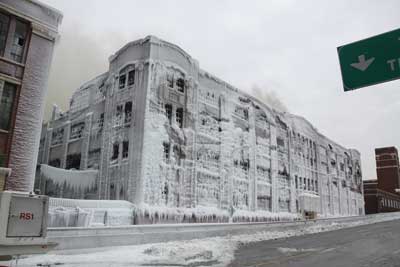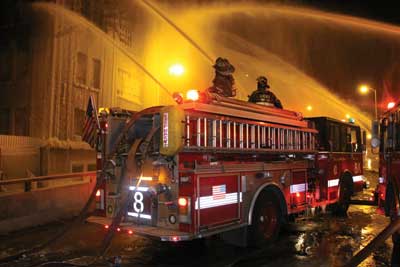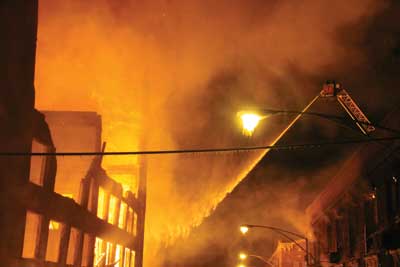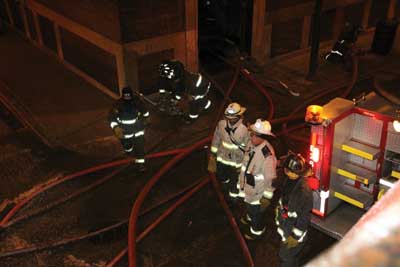By Erich J. Roden
Any Midwest firefighter will tell you that January brings tough fire duty because of inclement weather. Chicago (IL) Fire Department (CFD) personnel knew this all too well on January 22 when they were faced with the largest fire they had seen in years, according to a CFD spokesman. The temperature in Chicago was a miserable 10°F, with a rapidly dropping wind chill, when a 200- × 200-foot vacant, boarded-up warehouse fire became an inferno, making national headlines the next morning when its remnants became a palatial, frozen ruin. The fire eventually extended to a similar, adjacent commercial building but was quickly stopped by determined CFD companies.
 |
| (1) The fire became an inferno that made national news when it became a palatial, frozen ruin dubbed the “Ice Palace.” Incident commanders must take into account the weight of the ice on the exterior and floors and roofs, as well as the potential for collapse at any time during the days companies will surely operate until the “hot spots” are extinguished. (Photos by Tim Olk.) |
Greater-alarm fires are inherently tough in any weather condition-and exponentially tougher when temperatures drop below freezing. The initial incident commander (IC) already has a lot on his plate as first-alarm companies begin operating at a fire everyone knows will escalate. As successive alarm companies arrive, the IC must take into consideration what the temperature is about to do to the entire operation and begin managing the problems everyone is sure to face.
When multiple units are called during escalating alarms to provide and flow water, always be concerned about relying on the area’s serviceable hydrants when determining the amount of water you will need for heavily involved fire buildings. In warmer or temperate climates, the main concern is usually drawing too much water from only a few water mains, decreasing the available volume needed for additional elevated master streams. In colder climates, this problem is compounded when these same hydrants also become frozen or inoperable. This creates a delay in water for master stream devices because of longer hoselays to a serviceable hydrant farther down the block. Moreover, as engine companies lay these long supply lines to find a working hydrant, apparatus positioning becomes an additional concern as large hoselines dropped in the street begin to block out later-arriving truck companies-from right when and where you need them.
 |
| (2) This fire, which occurred on January 22, 2013, went to five alarms and two specials in subzero temperatures. The fire consumed an approximately 200- × 200-foot vacant warehouse and extended to an adjacent commercial building. |
Always test hydrants for serviceability prior to connecting to a supply engine at any fire. In subzero temperatures, however, a hydrant can also freeze up once you have tested it and closed it for later use. If an engine company plans on using a hydrant to supply a master stream or perform an inline pumping operation, it should find a secondary hydrant in a direction opposite the fire building. This will ensure that an engine company’s water supply plans A and B are established before the engine is ordered to connect and start water to the fireground. Also consider your Water Department’s resources, and contact them early on when additional alarms are called, as they often have equipment or heating devices to thaw frozen hydrants. Plan C!
 |
| (3) A Chicago Fire Department (CFD) engine company operates its deck gun in conjunction with other master stream devices. In subzero temperatures, the incident commander (IC) must understand what the temperature is going to do to the entire operation once water starts on the fire. The IC must also expect water problems in virtually every part of the delivery system: hydrants, hoselines, pumps, and aerials. Engine companies must always conceive their plans A and B simultaneously because of potential unserviceable hydrants. |
Hoselines on the fireground also succumb to freezing temperatures: 2 1⁄2-inch hoselines at greater-alarm fires are often ordered opened and shut down numerous times for repositioning or redeployment out of collapse zones. When closing the nozzle in freezing temperatures, it is advisable to keep the nozzle’s bail partially open to keep a steady trickle of water coming out. This will greatly reduce the chances of the hoseline freezing and will only cause minor ice conditions around the engine company’s position. The hose itself often freezes if it is anywhere near an operating elevated master stream’s nozzle or an engine company’s deck gun runoff and overspray.
 |
| (4) A CFD engine company operates a portable deck gun onto the fire building. The fire extended to an adjacent exposure but was quickly stopped by determined firefighters and well-placed water from master streams. |
Once the hose itself gets wet, its jacket will freeze, making the hose more difficult to maneuver. Additional engine companies-standing by to relieve a frozen company-should assist with any hose maneuvering. The 2 1⁄2-inch hose weighs in excess of 150 pounds per length when charged, and at fires like this one in Chicago there was a lot of it.
Master streams will place a tremendous amount of water on and around the fire building at any greater-alarm fire. When water freezes as it is applied, the IC must take into account the weight of water on the building’s exterior walls, floors, and roof. For example, water cascaded for hours at this fire, creating the aforementioned palatial, frozen ruin-news outlets fittingly referred to the fire building as an “Ice Palace.” As tower ladders and deck guns begin applying water to the underside of the roof decking or floors, ice will also accumulate under the roof and onto the floor below, increasing the potential for a partial or total collapse of the remaining roof and floors. Additionally, as water turns to ice, its volume expands. When ice expands between structural connections and joints already weakened by an advanced fire, collapse is all but certain under the accumulated weight of frozen water. Collapse zones should also address large chunks of this accumulated ice coming your way, in addition to the thousands of bricks such as the ones comprising this warehouse’s exterior.
 |
| (5) This devastating fire was held to the original fire building and an adjacent exposure because of the tremendous efforts of the CFD’s firefighters. The CFD has seen its share of greater-alarm fires throughout the course of its history and demonstrably showed its capability to handle fires of this magnitude by incorporating the lessons learned at these fires. |
Relief of personnel is an increasing concern at greater-alarm fires in subzero temperatures. Do not take lightly the effects of the cold on operating firefighters. There is always a tremendous amount of tools and equipment to be moved, repositioned, and set up at greater-alarm fires. When firefighters have been subjected to subzero temperatures for an extended period of time, some operations may come to a crawl. When nonfrozen personnel relieve firefighters’ positions or operations, do not allow the relieved firefighters to be cycled back into the operation; consider calling more resources such as mutual-aid or station-transfer (move-ups) companies, and have relieved firefighters hit the coffee truck (rehab) for the duration. Just as few firefighters ever want to be relieved at a fire, the same mindset prevails with chief officers, too. Chief officers are often exposed to the same elements as operating companies when they are assigned sectors, divisions, or groups for extended durations.
 |
| (6) Chief officers should also be put on the list to be relieved during greater alarms in subzero temperatures. Because chief officers are assigned divisions, groups, and sectors during these incidents, they are subjected to the same elements as operating companies-and for extended durations. |
The CFD has seen its share of greater-alarm fires throughout history and has seen a countless number in subzero temperatures. The lessons personnel have learned and operationally instituted were demonstrably evident on January 22, 2013. The CFD was able to contain a devastating fire to the original fire building and one exposure. That is a testament to heeding the lessons learned from prior fires and that the CFD can handle what comes its way in any weather.
● ERICH RODEN is the co-editor of Urban Firefighter and is a battalion chief assigned to the Training Division of the Milwaukee (WI) Fire Department. He is a member of the FDIC Executive Advisory Board, is a lead instructor for the FDIC “Urban Essentials” H.O.T. evolution, and was previously a H.O.T. instructor for “Engine Company Operations.” He is also a fire service instructor for the Milwaukee Area Technical College.
More Fire Engineering Issue Articles
Fire Engineering Archives

